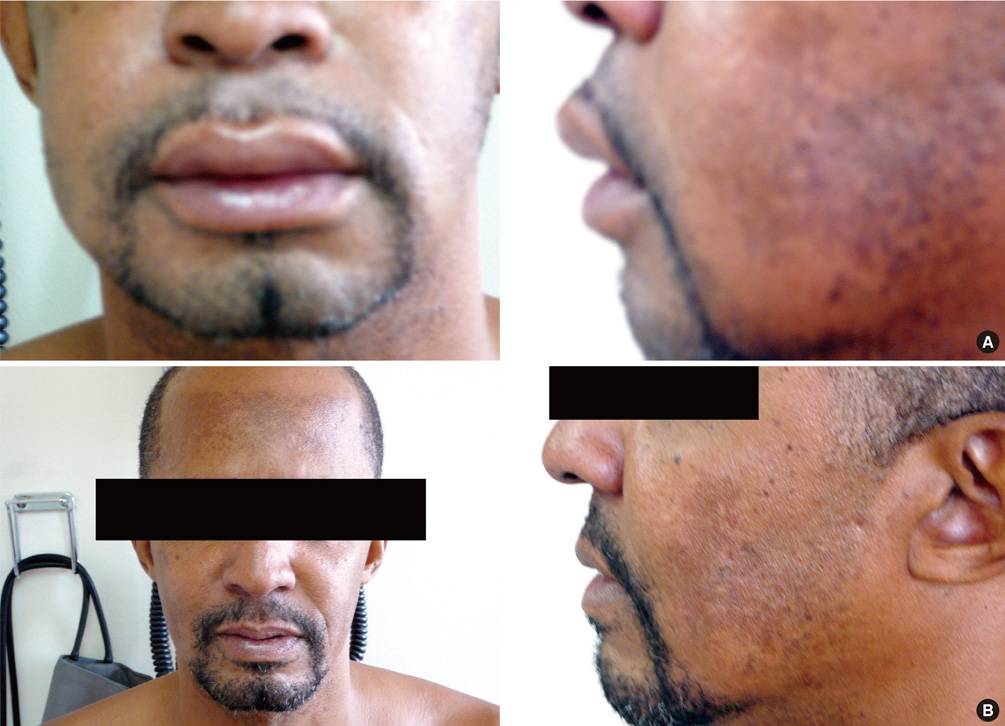Allergy Asthma Immunol Res.
2010 Jul;2(3):195-198. 10.4168/aair.2010.2.3.195.
Angiotensin-Converting Enzyme Inhibitors and Angioedema
- Affiliations
-
- 1Allergy and Clinical Immunology Department, Centro Medico-Docente La Trinidad, Caracas, Venezuela. sanchezbmario@gmail.com
- 2Allergy and Immunology Department, Clinica El Avila, Caracas, Venezuela.
- 3Dermatology Department, Centro Medico de Caracas, Caracas, Venezuela.
- KMID: 2133808
- DOI: http://doi.org/10.4168/aair.2010.2.3.195
Abstract
- PURPOSE
To investigate the incidence and clinical characteristics of angioedema associated with the use of angiotensin-converting enzyme inhibitors (ACEIs) in an outpatient allergy department.
METHODS
A retrospective review of medical records of new patients seen in an allergy clinic. Demographic and clinical data of patients with ACEI-induced angioedema were analyzed.
RESULTS
Nine (0.37%) out of 2,421 new patients attending the allergy clinic developed ACEI-associated angioedema. Enalapril was the drug most frequently incriminated. The onset of the angioedema was as early as after the first dose or as late as 2 years after beginning treatment. Six patients experienced life-threatening angioedema involving the tongue, oropharynx, or larynx, and two patients required transfer to the intensive care unit. One patient required a tracheostomy.
CONCLUSIONS
Angiotensin-converting enzyme inhibitor treatment is often responsible for angioedema, especially involving the upper airways. Due to the high proportion of the population exposed to ACEIs and to the severity of this adverse effect, it is important that physicians consider ACEIs as possible inducers when evaluating patients with acute or recurrent angioedema.
MeSH Terms
-
Angioedema
Angiotensin-Converting Enzyme Inhibitors
Bradykinin
Captopril
Cinnarizine
Enalapril
Humans
Hypersensitivity
Incidence
Intensive Care Units
Larynx
Medical Records
Oropharynx
Outpatients
Retrospective Studies
Tongue
Tracheostomy
Angiotensin-Converting Enzyme Inhibitors
Bradykinin
Captopril
Cinnarizine
Enalapril
Figure
Reference
-
1. Cicardi M, Agostoni A. Hereditary angioedema. N Engl J Med. 1996. 334:1666–1667.2. Quincke H. Über akutes umschriebenes Hautödem. Monatsh Prakt Dermatol. 1882. 1:129–131.3. Lombardi C, Crivellaro M, Dama A, Senna G, Gargioni S, Passalacqua G. Are physicians aware of the side effects of angiotensin-converting enzyme inhibitors?: a questionnaire survey in different medical categories. Chest. 2005. 128:976–979.4. Howes LG, Tran D. Can angiotensin receptor antagonists be used safely in patients with previous ACE inhibitor-induced angioedema? Drug Saf. 2002. 25:73–76.5. Miller DR, Oliveria SA, Berlowitz DR, Fincke BG, Stang P, Lillienfeld DE. Angioedema incidence in US veterans initiating angiotensin-converting enzyme inhibitors. Hypertension. 2008. 51:1624–1630.6. Sarkar P, Nicholson G, Hall G. Brief review: angiotensin converting enzyme inhibitors and angioedema: anesthetic implications. Can J Anaesth. 2006. 53:994–1003.7. Slater EE, Merrill DD, Guess HA, Roylance PJ, Cooper WD, Inman WH, Ewan PW. Clinical profile of angioedema associated with angiotensin converting-enzyme inhibition. JAMA. 1988. 260:967–970.8. Dean DE, Schultz DL, Powers RH. Asphyxia due to angiotensin converting enzyme (ACE) inhibitor mediated angioedema of the tongue during the treatment of hypertensive heart disease. J Forensic Sci. 2001. 46:1239–1243.9. Cupido C, Rayner B. Life-threatening angio-oedema and death associated with the ACE inhibitor enalapril. S Afr Med J. 2007. 97:244–245.10. Mlynarek A, Hagr A, Kost K. Angiotensin-converting enzyme inhibitor-induced unilateral tongue angioedema. Otolaryngol Head Neck Surg. 2003. 129:593–595.11. Byrd JB, Touzin K, Sile S, Gainer JV, Yu C, Nadeau J, Adam A, Brown NJ. Dipeptidyl peptidase IV in angiotensin-converting enzyme inhibitor associated angioedema. Hypertension. 2008. 51:141–147.12. Duan QL, Nikpoor B, Dube MP, Molinaro G, Meijer IA, Dion P, Rochefort D, Saint-Onge J, Flury L, Brown NJ, Gainer JV, Rouleau JL, Agostoni A, Cugno M, Simon P, Clavel P, Potier J, Wehbe B, Benarbia S, Marc-Aurele J, Chanard J, Foroud T, Adam A, Rouleau GA. A variant in XPNPEP2 is associated with angioedema induced by angiotensin I-converting enzyme inhibitors. Am J Hum Genet. 2005. 77:617–626.13. Oike Y, Ogata Y, Higashi D, Matsumura T, Numata Y. Fatal angioedema associated with enalapril. Intern Med. 1993. 32:308–310.14. Kostis JB, Kim HJ, Rusnak J, Casale T, Kaplan A, Corren J, Levy E. Incidence and characteristics of angioedema associated with enalapril. Arch Intern Med. 2005. 165:1637–1642.15. Chin HL, Buchan DA. Severe angioedema after long-term use of an angiotensin-converting enzyme inhibitor. Ann Intern Med. 1990. 112:312–313.16. Kampitak T. Recurrent severe angioedema associated with imidapril and diclofenac. Allergol Int. 2008. 57:441–443.17. Kamata Y, Iwamoto M, Kamimura T, Kanashiki E, Yoshio T, Okazaki H, Morita T, Minota S. Repeated massive tongue swelling due to the combined use of estramustine phosphate and angiotensin-converting enzyme inhibitor. J Investig Allergol Clin Immunol. 2006. 16:388–390.18. Morimoto T, Gandhi TK, Fiskio JM, Seger AC, So JW, Cook EF, Fukui T, Bates DW. An evaluation of risk factors for adverse drug events associated with angiotensin-converting enzyme inhibitors. J Eval Clin Pract. 2004. 10:499–509.19. Abbosh J, Anderson JA, Levine AB, Kupin WL. Angiotensin converting enzyme inhibitor-induced angioedema more prevalent in transplant patients. Ann Allergy Asthma Immunol. 1999. 82:473–476.20. Malde B, Regalado J, Greenberger PA. Investigation of angioedema associated with the use of angiotensin-converting enzyme inhibitors and angiotensin receptor blockers. Ann Allergy Asthma Immunol. 2007. 98:57–63.21. Weber MA, Messerli FH. Angiotensin-converting enzyme inhibitors and angioedema: estimating the risk. Hypertension. 2008. 51:1465–1467.
- Full Text Links
- Actions
-
Cited
- CITED
-
- Close
- Share
- Similar articles
-
- Effect of Angiotensin Converting Enzyme Inhibitors on Induced Angiotensin Converting Enzyme Activity in Rat Intestine
- Tranexamic acid for angiotensin-converting enzyme inhibitor–induced angioedema
- A case of angioedema associated with losartan
- Angiotensin Converting Enzyme Inhibitors for the
- A Case of Angioedema Probably Induced by Captopril


